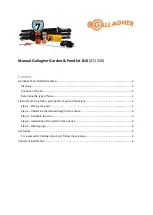
MENTOR 12 US
SECTION 2: BASIC CONTROL – Page 42
ER’S MANUAL
•
one or several fuses that a
source contains as final protection has or have blown and must be replaced
to be able to continue using it. When this occurs the module affected must be
taken out, following the instructions given in the Basic Maintenance section of
this manual, and the fuse affected replaced.
circuit. The appearance of this type of alarm implies an instantaneous
disconnection of the sources affected by it.
THERM
.- This means that the source affected has surpassed the admissible
thermal limits for correct operation. When this a
•
larm appears it implies the
immediate disconnection of the source affected and the deactivation of the
relative On/Off key. After a cooling time (this may be several minutes), when
the temperature returns to safe values, this alarm resets on its own, enabling
the source to operate again.
Vout
.- This means that the source is not giving the values that it should give
in its outputs. It may appear in the Source or in the Amplifier. The appearance
of this alarm implies an immediate disconnection of the source affected. This
alarm generally
•
indicates a FAULT in the source affected, so it does not reset
on its own. When this type of alarm occurs, it is advisable to reset the
equipment, by switching it off and then on again. If the alarm appears again
after switching it back on, this definitely indicates that the source is out of
service due to a fault.
FUSE
.- The appearance of this alarm indicates that
















































